
Benevento is a city and comune of Campania, Italy, capital of the province of Benevento, 50 kilometres (31 mi) northeast of Naples. It is situated on a hill 130 metres above sea level at the confluence of the Calore Irpino and the Sabato. In 2020, Benevento has 58,418 inhabitants. It is also the seat of a Catholic archbishop.
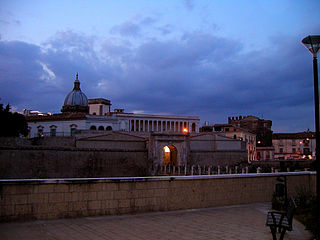
Capua is a city and comune in the province of Caserta, in the region of Campania, southern Italy, situated 25 km (16 mi) north of Naples, on the northeastern edge of the Campanian plain.

The Allied invasion of Italy was the Allied amphibious landing on mainland Italy that took place from 3 September 1943, during the Italian campaign of World War II. The operation was undertaken by General Sir Harold Alexander's 15th Army Group and followed the successful Allied invasion of Sicily. The main invasion force landed on the west coast of Italy at Salerno on September 9 as part of Operation Avalanche, while two supporting operations took place in Calabria and Taranto.

The province of Avellino is a province in the Campania region of Italy. Its capital is the city of Avellino. The area is characterized by numerous small towns and villages scattered across the province; only two towns have a population over 20,000.
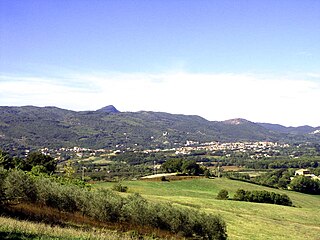
The province of Caserta is a province in the Campania region of Italy. Its capital is the city of Caserta, situated about 36 kilometres (22 mi) by road north of Naples. The province has an area of 2,651.35 square kilometres (1,023.69 sq mi), and had a total population of 924,414 in 2016. The Palace of Caserta is located near to the city, a former royal residence which was constructed for the Bourbon kings of Naples. It was the largest palace and one of the largest buildings erected in Europe during the 18th century. In 1997, the palace was designated a UNESCO World Heritage Site.

The Calore Irpino or Calore Beneventano or Calore river is a river in southwestern Italy. It rises from Colle Finestra, a mountain saddle between Monte Acellica and the Terminio sub-group in the Monti Picentini, sub-range of the Apennine Mountains. The river flows first in the province of Avellino, and then in that of Benevento, before flowing into the Volturno. In ancient times it was known as Calor.

Caiazzo is a city and comune in the province of Caserta (Campania) in Italy. It is located on the right bank of the Volturnus, some 20 kilometres (12 mi) northeast of Capua.
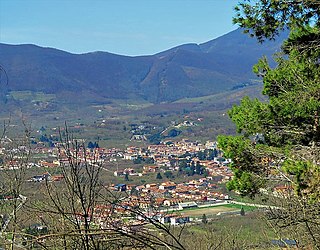
Forino is a town and comune in the province of Avellino, Campania, southern Italy.

Baia e Latina is a comune (municipality) in the Province of Caserta in the Italian region Campania, located about 50 kilometres (31 mi) north of Naples and about 25 kilometres (16 mi) northwest of Caserta.
Castel Campagnano is a comune (municipality) in the Province of Caserta in the Italian region Campania, located about 40 kilometres (25 mi) northeast of Naples and about 15 kilometres (9 mi) northeast of Caserta.
Castel di Sasso is a comune (municipality) in the Province of Caserta in the Italian region Campania, located about 40 kilometres (25 mi) north of Naples and about 14 kilometres (9 mi) northwest of Caserta.
Castel Morrone is a comune (municipality) in the Province of Caserta in the Italian region Campania, located about 35 kilometres (22 mi) north of Naples and about 6 kilometres (4 mi) north of Caserta.
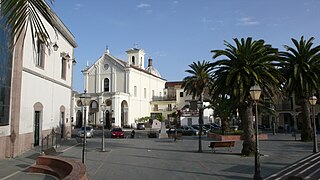
Castel Volturno is a comune (municipality) in the Province of Caserta in the Italian region Campania, located about 35 kilometres (22 mi) northwest of Naples and about 35 kilometres (22 mi) west of Caserta on the Volturno river. In 2010 Castel Volturno was inhabited by 25,000 locals and about 18,000 African refugees. Today (2019) there are still about 25,000 people, estimated two-thirds of them are immigrants.
Piana di Monte Verna is a comune (municipality) in the Province of Caserta in the Italian region Campania, located about 40 kilometres (25 mi) north of Naples and about 11 kilometres (7 mi) north of Caserta.
Dugenta is a comune (municipality) in the Province of Benevento in the Italian region Campania, located about 35 kilometres (22 mi) northeast of Naples and about 30 kilometres (19 mi) west of Benevento.
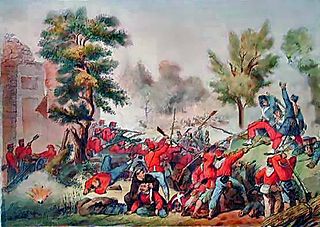
The Battle of the Volturno refers to a series of military clashes between Giuseppe Garibaldi's volunteers and the troops of the Kingdom of Two Sicilies occurring around the River Volturno, between the cities of Capua and Caserta in northern Campania, in September and October 1860. The main battle took place on 1 October 1860 between 30,000 Garibaldines and 25,000 Bourbon troops (Neapolitans).

Naples Metropolitan Railway service are two independent companies that operate a commuter rail system in Naples. The first one, Trenitalia, operates line 2 from Pozzuoli Solfatara to Gianturco station in East of Naples. The other one, EAV, operates the Circumvesuviana, Cumana, Circumflegrea and MetroCampania NordEst. In Italy, Naples is the only city possessing two independent metropolitan railway service companies.
The Matese Legion was a group of 240 Italian volunteers that joined Giuseppe Garibaldi in the war for Italian unification in 1861. It was formed in Piedimonte D'Alife, now called Piedimonte Matese, in June 1860, and was officially established on 25 August of the same year. Membership in the legion gradually declined, and it broke apart on 3 March 1861.

The Caiazzo massacre was the massacre of 22 Italian civilians at Caiazzo, Campania, Southern Italy, on 13 October 1943, during World War II by members of the German 3rd Panzergrenadier Division. The massacre was described as having been of a particularly brutal nature and its leader, Lieutenant Wolfgang Lehnigk-Emden, was soon after captured by Allied forces. Lehnigk-Emden confessed to part of the crime but was later accidentally released and, for the next four decades, was not put on trial.

The geography of Campania illustrates the geographical characteristics of Campania, a region of Italy.















